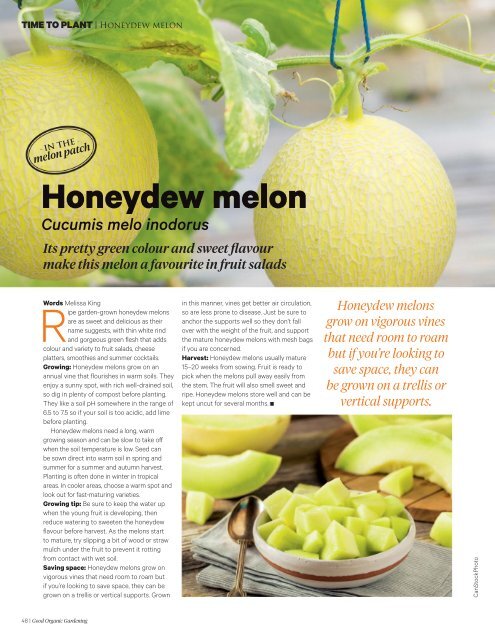6. Good Organic Gardening - November-December 2016 AvxHome.in
6. Good Organic Gardening - November-December 2016 AvxHome.in
6. Good Organic Gardening - November-December 2016 AvxHome.in
You also want an ePaper? Increase the reach of your titles
YUMPU automatically turns print PDFs into web optimized ePapers that Google loves.
TIME TO PLANT | Honeydew melon<br />
- <strong>in</strong> the -<br />
melon patch<br />
Honeydew melon<br />
Cucumis melo <strong>in</strong>odorus<br />
Its pretty green colour and sweet flavour<br />
make this melon a favourite <strong>in</strong> fruit salads<br />
Words Melissa K<strong>in</strong>g<br />
Ripe garden-grown honeydew melons<br />
are as sweet and delicious as their<br />
name suggests, with th<strong>in</strong> white r<strong>in</strong>d<br />
and gorgeous green flesh that adds<br />
colour and variety to fruit salads, cheese<br />
platters, smoothies and summer cocktails.<br />
Grow<strong>in</strong>g: Honeydew melons grow on an<br />
annual v<strong>in</strong>e that flourishes <strong>in</strong> warm soils. They<br />
enjoy a sunny spot, with rich well-dra<strong>in</strong>ed soil,<br />
so dig <strong>in</strong> plenty of compost before plant<strong>in</strong>g.<br />
They like a soil pH somewhere <strong>in</strong> the range of<br />
<strong>6.</strong>5 to 7.5 so if your soil is too acidic, add lime<br />
before plant<strong>in</strong>g.<br />
Honeydew melons need a long, warm<br />
grow<strong>in</strong>g season and can be slow to take off<br />
when the soil temperature is low. Seed can<br />
be sown direct <strong>in</strong>to warm soil <strong>in</strong> spr<strong>in</strong>g and<br />
summer for a summer and autumn harvest.<br />
Plant<strong>in</strong>g is often done <strong>in</strong> w<strong>in</strong>ter <strong>in</strong> tropical<br />
areas. In cooler areas, choose a warm spot and<br />
look out for fast-matur<strong>in</strong>g varieties.<br />
Grow<strong>in</strong>g tip: Be sure to keep the water up<br />
when the young fruit is develop<strong>in</strong>g, then<br />
reduce water<strong>in</strong>g to sweeten the honeydew<br />
flavour before harvest. As the melons start<br />
to mature, try slipp<strong>in</strong>g a bit of wood or straw<br />
mulch under the fruit to prevent it rott<strong>in</strong>g<br />
from contact with wet soil.<br />
Sav<strong>in</strong>g space: Honeydew melons grow on<br />
vigorous v<strong>in</strong>es that need room to roam but<br />
if you’re look<strong>in</strong>g to save space, they can be<br />
grown on a trellis or vertical supports. Grown<br />
<strong>in</strong> this manner, v<strong>in</strong>es get better air circulation,<br />
so are less prone to disease. Just be sure to<br />
anchor the supports well so they don’t fall<br />
over with the weight of the fruit, and support<br />
the mature honeydew melons with mesh bags<br />
if you are concerned.<br />
Harvest: Honeydew melons usually mature<br />
15–20 weeks from sow<strong>in</strong>g. Fruit is ready to<br />
pick when the melons pull away easily from<br />
the stem. The fruit will also smell sweet and<br />
ripe. Honeydew melons store well and can be<br />
kept uncut for several months.<br />
Honeydew melons<br />
grow on vigorous v<strong>in</strong>es<br />
that need room to roam<br />
but if you’re look<strong>in</strong>g to<br />
save space, they can<br />
be grown on a trellis or<br />
vertical supports.<br />
CanStockPhoto<br />
48 | <strong>Good</strong> <strong>Organic</strong> <strong>Garden<strong>in</strong>g</strong>

















